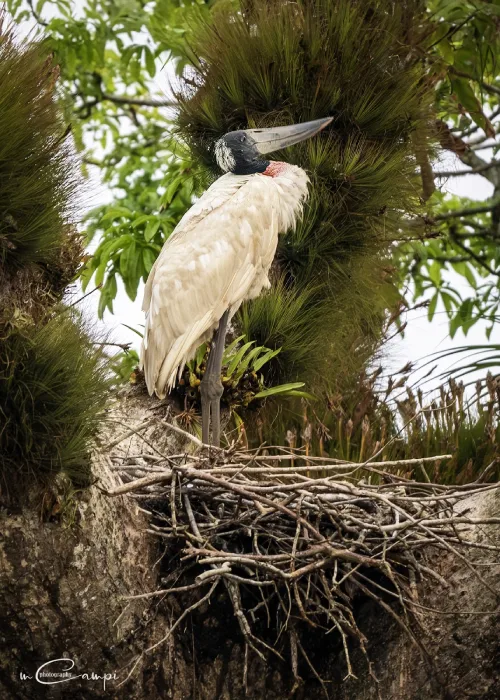Jabiru
The Jabiru , with its impressive stature and vital role in wetland ecosystems, is a birdwatcher's delight, particularly in Costa Rica's rich natural reserves.

Jabiru mycteria
Scientific Name
Ciconiidae (Storks)
Family
Ciconiiformes
Order
Monotypic species, no recognized subspecies.
Subspecies.
Range and Habitat
Geographic Range
Found from Mexico through Central America, including Costa Rica, and into South America down to Argentina.
Migratory Patterns
Non-migratory, but may make local movements depending on water availability during the dry season.
Preferred Habitat
Jabiru favors large freshwater wetlands, marshes, floodplains, and riversides.
Altitude Range
Prefers lowland areas but may be seen up to 500 meters (1,640 feet) in elevation.
Costa Rica Habitat
In Costa Rica, important habitats include Palo Verde National Park and Caño Negro Wildlife Refuge. Jabiru is found primarily in the northern lowlands, particularly in the wetlands of Guanacaste and the Caribbean.
Conservation Status
Least Concern
Conservation Status
Population Status
Globally stable, but local populations can be threatened by habitat loss, particularly in areas where wetlands are drained for agriculture.
Wetland degradation and drainage. Pollution and water contamination.
Conservation efforts
Protected in several national parks and reserves in Costa Rica, particularly in Palo Verde National Park and Caño Negro, which provide critical wetland habitats.
Primary Threats
Wetland degradation and drainage. Pollution and water contamination.
Identification
Jabiru
Rarity Level:
CommonBest Viewing Times:
Early Morning (Dawn - 8 AM), Late Morning (8 AM - 11 AM), Midday (11 AM - 2 PM)
Size
Height: 120-140 cm (3.9-4.6 feet). Wingspan: Up to 2.8 meters (9.2 feet), making it one of the largest flying birds in the Americas. Weight: 8-10 kg (17-22 lbs).
Plumage
White body with a bare black head and neck. The most distinctive feature is a bright red band at the base of the neck.
Distinctive Features
A large, robust black bill that can be up to 30 cm (12 inches) long. Its imposing size and striking red neckband make it unmistakable.
Sexual Dimorphism
Minimal; males tend to be slightly larger than females, but both sexes share similar plumage.
Diet and Feeding Behavior
Primary Diet
- Primarily feeds on fish, but will also consume amphibians, reptiles, and small mammals. In times of scarcity, it may scavenge.
Foraging Techniques
- Wades through shallow water, using its large bill to feel and catch prey by touch. Sometimes seen stirring the water with its feet to disturb hiding fish.
Feeding Times
- Mostly diurnal, foraging throughout the day.
Behavior Patterns
Jabiru
Lorem ipsum dolor sit amet, consectetur adipiscing elit, sed do eiusmod tempor incididunt ut labore et dolore magna aliqua.
Social Structure
Generally solitary or seen in pairs, though small groups may form around abundant food sources.
Song and Vocalization
Silent for the most part, though it may produce low bill-clattering sounds, especially during courtship or when alarmed.
Courtship and Mating Ritual
Courtship involves synchronized bill-clattering and mutual preening between the pair. They often return to the same nesting site year after year.
Territoriality
Jabirus are territorial during the breeding season and will defend their nesting areas from other storks.
Birdwatching Tips
Best Locations
Some of the best spots to see Jabiru in Costa Rica:
- Palo Verde National Park in Guanacaste is one of the best locations to observe Jabirus.
- Caño Negro Wildlife Refuge is another prime site, especially for wetland birdwatching.

Best Time of the Year
Year-round, though the dry season (December to April) is the best time to spot Jabiru Stork as wetlands shrink, concentrating bird activity.
Common Behavior
Look for them in wetlands and marshy areas, where they can often be seen wading slowly in shallow water in search of food.
Recommended Gear
A spotting scope is ideal for long-distance viewing, as Jabirus often feed far from shore. Binoculars and a good telephoto lens are also recommended.
Breeding and Nesting Behavior
Breeding Season
In Costa Rica, the breeding season is during the dry months, from December to May.
Nesting Sites
Builds large, platform nests high in trees, often near wetlands. The nests are constructed from sticks and lined with softer materials.
Clutch Size
Typically 2-4 eggs.
Incubation Period
{acf_breeding_and_nesting_incubation_period}
Parental Care
Both parents share duties in incubating the eggs and feeding the chicks after hatching.
Did You Know?
How do I identify this bird?
Its large size, bright white body, bare black head, and distinctive red neckband make the Jabiru unmistakable. Look for its towering presence in wetland areas.
Where is the best place to see it?
In Costa Rica, head to Palo Verde National Park or Caño Negro Wildlife Refuge. Both are wetland areas known for Jabiru sightings.
Is this bird endangered?
While not globally endangered, some populations are vulnerable due to habitat destruction and wetland drainage.
Interesting Behaviors
Jabiru nests are reused year after year, often growing to impressive sizes as the storks add new material each season.
Despite their large size, Jabirus are powerful fliers, covering vast distances in search of food and suitable nesting sites.Cultural Significance
The Jabiru is a significant symbol of wetlands and river ecosystems in many parts of Central and South America, often representing purity and connection to water.
Sets a Record
The Jabiru is the largest flying bird in the Americas.
Not a picky eater
This bird will consume fish, frogs, snakes, insects crabs, turtles, and even young crocodiles and caiman.